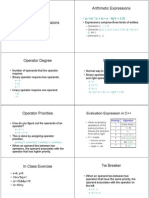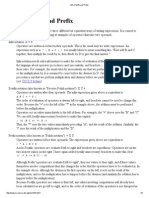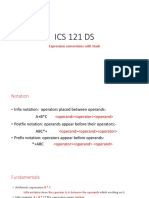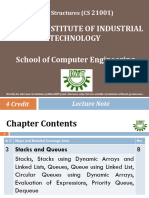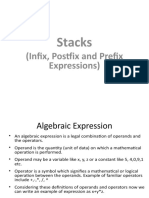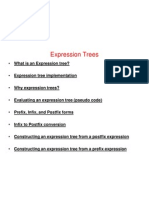Data Structure - Expression Parsing - Tutorialspoint
Uploaded by
John AndrewData Structure - Expression Parsing - Tutorialspoint
Uploaded by
John Andrew3/12/2021 Data Structure - Expression Parsing - Tutorialspoint 3/12/2021 Data Structure - Expression Parsing - Tutorialspoint
Sr.No. Infix Notation Prefix Notation Postfix Notation
Data Structure - Expression Parsing 1 a+b +ab ab+
2 (a + b) ∗ c ∗+abc ab+c∗
3 a ∗ (b + c) ∗a+bc abc+∗
The way to write arithmetic expression is known as a notation.
notation. An arithmetic expression can be
written in three different but equivalent notations, i.e., without changing the essence or output of 4 a/b+c/d +/ab/cd ab/cd/+
an expression. These notations are −
Infix Notation 5 (a + b) ∗ (c + d) ∗+ab+cd ab+cd+∗
Prefix (Polish) Notation 6 ((a + b) ∗ c) - d -∗+abcd ab+c∗d-
Postfix (Reverse-Polish) Notation
These notations are named as how they use operator in expression. We shall learn the same Parsing Expressions
here in this chapter.
As we have discussed, it is not a very efficient way to design an algorithm or program to parse
Infix Notation infix notations. Instead, these infix notations are first converted into either postfix or prefix
notations and then computed.
We write expression in infix notation, e.g. a - b + c, where operators are used in-between
in-between
To parse any arithmetic expression, we need to take care of operator precedence and
operands. It is easy for us humans to read, write, and speak in infix notation but the same does
associativity also.
not go well with computing devices. An algorithm to process infix notation could be difficult and
costly in terms of time and space consumption.
Precedence
Prefix Notation When an operand is in between two different operators, which operator will take the operand
first, is decided by the precedence of an operator over others. For example −
In this notation, operator is prefixed
prefixed to operands, i.e. operator is written ahead of operands. For
example, +ab.
+ab. This is equivalent to its infix notation a + b.
b. Prefix notation is also known as
Polish Notation.
Notation.
As multiplication operation has precedence over addition, b * c will be evaluated first. A table of
Postfix Notation operator precedence is provided later.
This notation style is known as Reversed Polish Notation.
Notation. In this notation style, the operator is
postfixed
postfixed to the operands i.e., the operator is written after the operands. For example, ab+.ab+. Associativity
This is equivalent to its infix notation a + b.
b. Associativity describes the rule where operators with the same precedence appear in an
The following table briefly tries to show the difference in all three notations − expression. For example, in expression a + b − c, both + and – have the same precedence,
then which part of the expression will be evaluated first, is determined by associativity of those
operators. Here, both + and − are left associative, so the expression will be evaluated as (a + b)
− c.
c.
Precedence and associativity determines the order of evaluation of an expression. Following is
an operator precedence and associativity table (highest to lowest) −
https://www.tutorialspoint.com/data_structures_algorithms/expression_parsing.htm 1/3 https://www.tutorialspoint.com/data_structures_algorithms/expression_parsing.htm 2/3
3/12/2021 Data Structure - Expression Parsing - Tutorialspoint
Sr.No. Operator Precedence Associativity
1 Exponentiation ^ Highest Right Associative
2 Multiplication ( ∗ ) & Division ( / ) Second Highest Left Associative
3 Addition ( + ) & Subtraction ( − ) Lowest Left Associative
The above table shows the default behavior of operators. At any point of time in expression
evaluation, the order can be altered by using parenthesis. For example −
In a + b*c,
b*c, the expression part b*c will be evaluated first, with multiplication as precedence over
addition. We here use parenthesis for a + b to be evaluated first, like (a + b)*c.
b)*c.
Postfix Evaluation Algorithm
We shall now look at the algorithm on how to evaluate postfix notation −
Step 1 − scan the expression from left to right
Step 2 − if it is an operand push it to stack
Step 3 − if it is an operator pull operand from stack and perform operation
Step 4 − store the output of step 3, back to stack
Step 5 − scan the expression until all operands are consumed
Step 6 − pop the stack and perform operation
To see the implementation in C programming language, please click here .
https://www.tutorialspoint.com/data_structures_algorithms/expression_parsing.htm 3/3
You might also like
- The Psychology of The Language Learner Individual Differences in Second Language AcquisitionNo ratings yetThe Psychology of The Language Learner Individual Differences in Second Language Acquisition2 pages
- ECE 124 Digital Circuits and Systems Assignment #6No ratings yetECE 124 Digital Circuits and Systems Assignment #64 pages
- Data Structures and Algorithms - Maths NotationsNo ratings yetData Structures and Algorithms - Maths Notations3 pages
- 16 - Data Structure - Expression ParsingNo ratings yet16 - Data Structure - Expression Parsing5 pages
- Logic Arithmetic Algebra Operators Operands ArityNo ratings yetLogic Arithmetic Algebra Operators Operands Arity5 pages
- CS DataStructure-Lecture 6 - Polish NotationNo ratings yetCS DataStructure-Lecture 6 - Polish Notation35 pages
- Part 3 Expression Parsing in Data Structure C Program Examples 2No ratings yetPart 3 Expression Parsing in Data Structure C Program Examples 27 pages
- Infix, Postfix and Prefix: A (B + C) / DNo ratings yetInfix, Postfix and Prefix: A (B + C) / D2 pages
- Stacks: (Infix, Postfix and Prefix Expressions)No ratings yetStacks: (Infix, Postfix and Prefix Expressions)48 pages
- The Infix, Prefix, Postfix Notation:: Data Structure and AlgorithmsNo ratings yetThe Infix, Prefix, Postfix Notation:: Data Structure and Algorithms7 pages
- Infix, Prefix and Postfix Expression With Example - QuescolNo ratings yetInfix, Prefix and Postfix Expression With Example - Quescol5 pages
- Singly Linked List As Circular: ExampleNo ratings yetSingly Linked List As Circular: Example18 pages
- Stack & Queue Applications: Dept. of Computer Science Faculty of Science and TechnologyNo ratings yetStack & Queue Applications: Dept. of Computer Science Faculty of Science and Technology18 pages
- Lecture Slide of Expression in C ProgramNo ratings yetLecture Slide of Expression in C Program51 pages
- Arithmetic Expressions Conversion & Evaluation: Unit-2No ratings yetArithmetic Expressions Conversion & Evaluation: Unit-223 pages
- PROGRAMMING WITH PYTHON: Master the Basics and Beyond with Hands-On Projects and Expert Guidance (2024 Guide for Beginners)From EverandPROGRAMMING WITH PYTHON: Master the Basics and Beyond with Hands-On Projects and Expert Guidance (2024 Guide for Beginners)No ratings yet
- Formative Assessment of Test 2 Answer KeyNo ratings yetFormative Assessment of Test 2 Answer Key3 pages
- 24-Multi-Level Indexing, Dynamic Multilevel Indexing, B-Tree-11-09-2024No ratings yet24-Multi-Level Indexing, Dynamic Multilevel Indexing, B-Tree-11-09-202440 pages
- Examining The Physical Nature of The Imago Dei - Part 2bNo ratings yetExamining The Physical Nature of The Imago Dei - Part 2b9 pages
- Baym, N. K., Zhang, Y. B., and Lin, M-C. (2004)No ratings yetBaym, N. K., Zhang, Y. B., and Lin, M-C. (2004)36 pages
- Perfecto Mobile Performance User Guide - V4 August 2014No ratings yetPerfecto Mobile Performance User Guide - V4 August 201424 pages
- I Image Caption Generation Using Contextual Information Fusion With Bi-LSTM-sNo ratings yetI Image Caption Generation Using Contextual Information Fusion With Bi-LSTM-s10 pages
- TRANSITIONAL Words, Fanboys,+dependent+wordsNo ratings yetTRANSITIONAL Words, Fanboys,+dependent+words1 page
- Pedagogical Principles and Guidelines: Suggested English Curriculum 6 TO 11 GradeNo ratings yetPedagogical Principles and Guidelines: Suggested English Curriculum 6 TO 11 Grade40 pages
- EY3 ESL long-term plan - all Terms v4 (1)No ratings yetEY3 ESL long-term plan - all Terms v4 (1)22 pages





















